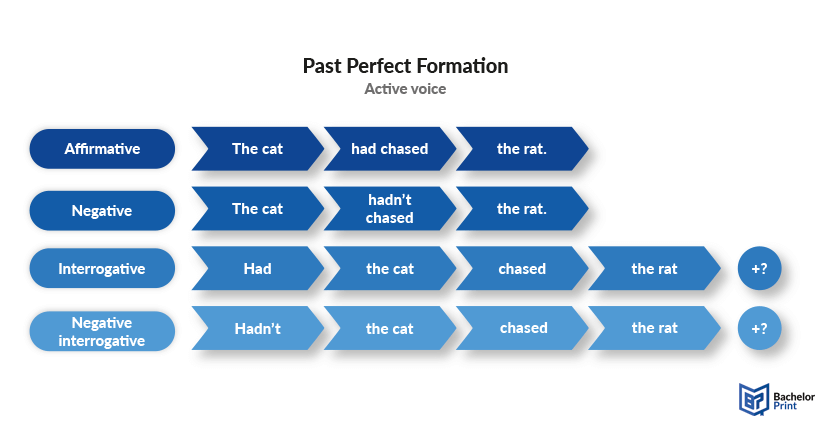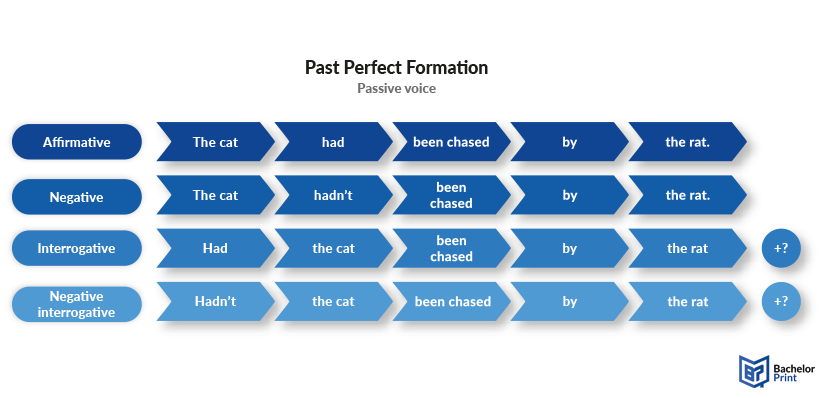
When diving into the complex world of language rules and tenses in English, one finds that time can be expressed in ways that aren’t just straightforward but layered. The past perfect tense is one such layered tense, allowing us to look back in the past within the past. In this article, we will thoroughly delve into its definition, usage, and characteristics by providing you with examples and exercises.
Definition: Past perfect
The past perfect, also known as pluperfect, is a verb tense that conveys the idea of an action that was completed at an earlier time than another action. It is often used when we need to establish which of two past actions happened first. This sense of “looking back from a past perspective” is unique to the past perfect, as it indicates both completion and sequence.
Formula of past perfect active voice
The past perfect is one of three perfect tenses – which include present perfect and future perfect – that play an important part in the English language. In the active voice, the past perfect follows a simple formula, as the structure remains consistent regardless of the subject. This means that there is no change based on subject-verb agreement, since the auxiliary verb “had” is used for all subjects and pronouns. Additionally, the past participle (3rd past form) of the main verb is used. A list of all irregular verb conjugations can be found in the download box below.
Structure
Subject + had + past participle + rest of the sentence.
Examples
Active question form of past perfect
To form questions in the past perfect tense, we move “had” to the beginning of the sentence, followed by the subject, the past participle, and of course, a question mark at the end.
Structure
Had + subject + past participle + rest of the sentence?
Examples
Negative question form of past perfect
In negative questions, the word “not” is inserted after “had.” The contraction “hadn’t” can be used as well. For negative questions with question words, you simply add the fitting one at the start of the sentence.
Structure
Had + subject + not + past participle + rest of the sentence?
Or
Hadn’t + subject + past participle + rest of the sentence?
Examples
Below, we have created an illustration that shows all structures of the past perfect active voice.

Practice worksheet
Before we dive into the passive voice, we have created a quick test with 10 questions. Simply, use the correct structure and fill in the gaps. The answers can be found in the second tab.
- She ____ her assignment before the deadline. (To finish, affirmative)
- They ____ Paris several times before moving there. (To visit, affirmative)
- ____ I ____ my keys at home before I reached work? (To forget, negative interrogative)
- The teacher ____ already ____ the lesson when I arrived. (To explain, affirmative)
- We ____ enough money to buy a house before we found one. (To save, affirmative)
- ____ he ____ hard before participating in the marathon? (To train, interrogative)
- The dog ____ all its food before we got home. (To eat, negative)
- I ____ never ____ such a beautiful painting before the gallery visit. (To see, affirmative)
- ____ they ____ the house before the storm hit? (To build, interrogative)
- She ____ the book before watching the movie. (To read, negative)
- She had finished her assignment before the deadline. (To finish, affirmative)
- They had visited Paris several times before moving there. (To visit, affirmative)
- Hadn’t I forgotten my keys at home before I reached work? (To forget, negative interrogative)
- The teacher had already explained the lesson when I arrived. (To explain, affirmative)
- We had saved enough money to buy a house before we found one. (To save, affirmative)
- Had he trained hard before participating in the marathon? (To train, interrogative)
- The dog had not eaten all its food before we got home. (To eat, negative)
- I had never seen such a beautiful painting before the gallery visit. (To see, affirmative)
- Had they built the house before the storm hit? (To build, interrogative)
- She had not read the book before watching the movie. (To read, negative)
Formula of past perfect passive voice
Now that we have completed the explanation of the past perfect active voice, we can move on to the passive voice. The difference from the active voice is that the focus shifts from the doer of the action to the receiver of it, creating a change in sentence structure. We add “been” between the auxiliary verb “had” and the main verb. The doer of the action is shown by the use of the “by” agent right before the object.
Structure
Subject + had + been + past participle (+ by agent) + object.
Examples
Structure
Subject + had + not + been + past participle (+ by agent) + object.
Or
Subject + hadn’t + been + past participle (+ by agent) + object.
Examples
Structure
Had + subject + been + past participle (+ by agent) + object?
Examples
Structure
Had + subject + not been + past participle (+ by agent) + object?
Or
Hadn’t + subject + been + past participle (+ by agent) + object?
Examples
The image below summarizes the form of the past perfect in passive voice.

Indicators of past perfect
The past perfect tense often works with certain time indicators to clarify the timeline of a series of actions. Here are common indicators along with several examples.
“Before” emphasizes that one action occurred prior to another.
However, there is something that should be noted with the second example.
Note: The past participle of “to get” is “gotten” in American English and “got” in British English.
This usage focuses on the fact that an action will be happening at a precise future time, and something might interrupt or simply coincide with that time.
“Already” is used to indicate an action was completed sooner than expected.
“Just” is often used with the past perfect to indicate that an action happened a short time before another event in the past.
Short answers in past perfect
In the past perfect, short answers refer to concise responses that either confirm or deny the occurrence of an action. They can be used in active and passive voice with the same structure.
Active voice
Structure
Affirmative: Yes, subject + had.
Negative: No, subject + hadn’t.
Passive voice
Structure
Affirmative: Yes, subject + had.
Negative: No, subject + hadn’t.
Past perfect vs. past simple
The past perfect and past simple tenses both refer to actions in the past, but they differ in their use and the relationship between events.
Past simple
The past simple (purple) describes an action that was completed in the past, often used when we focus on an event as a standalone occurrence.
Past perfect
The past perfect tense (orange), on the other hand, emphasizes that one action happened before another past action or a specific time in the past.
As we can see in those examples, past perfect occurs before another past action, while past simple is used for completed actions only without emphasis on another event or timeframe. Thus, past perfect typically sets the stage for another action (past simple) that follows it in the past.
Printing Your Thesis With BachelorPrint
- High-quality bindings with customizable embossing
- 3D live preview to check your work before ordering
- Free express delivery
Configure your binding now!
Past perfect subjunctive
The past perfect subjunctive has the same form as the past perfect; however, it is used to talk about hypothetical situations in the past. It is usually used in subordinate clauses and conditional sentences (third conditional) to express unreal situations in the past.
If you would like to learn more about the three moods or conditionals in the English language, the button below will refer you to our conjugation article.
Practice exercise
To wrap up this article, we have created a final exercise. As usual, the answers can be found in the second tab.
- She ____ her task before noon. (To complete, active, negative)
- ____ the project ____ before the manager arrived? (To complete, passive)
- ____ they ____ their presentation before the meeting started? (To finish, active)
- The invitations ____ out before the party was announced. (To send, passive, negative)
- ____ he ____ for the race before he got injured? (To train, active, negative)
- ____ the car ____ before we took the trip? (To repair, passive, negative)
- We ____ never ____ the museum before last weekend. (To visit, active)
- The letter ____ before we noticed. (To deliver, passive)
- ____ the teacher ____ the papers before class? (To grade, active)
- The food ____ before the guests arrived. (To prepare, passive, negative)
- She had not completed her task before noon. (To complete, active, negative)
- Had the project been completed before the manager arrived? (To complete, passive)
- Had they finished their presentation before the meeting started? (To finish, active)
- The invitations hadn’t been sent out before the party was announced. (To send, passive, negative)
- Had he not trained for the race before he got injured? (To train, active, negative)
- Had the car not been repaired before we took the trip? (To repair, passive, negative)
- We had never visited the museum before last weekend. (To visit, active)
- The letter had been delivered before we noticed. (To deliver, passive)
- Had the teacher graded the papers before class? (To grade, active)
- The food had not been prepared before the guests arrived. (To prepare, passive, negative)
FAQs
- She had already left by the time I arrived.
- They had finished dinner before the movie started.
- We had never seen that movie before last night.
- I had written the report before the deadline.
- He had just eaten when his friends arrived.
- By the time she called, I had completed my homework.
- The train had already departed when we reached the station.
- They had known each other for years before they got married.
- She had visited three countries before her 25th birthday.
- We had not met her before the conference last year.
The past perfect tense is used to show that an action was completed at an earlier time than another action. It is often used when two events occur, and one happened sooner than the other. It establishes a sequence of events, with the past perfect event happening first and the past simple event happening afterward.
Past simple describes simple actions that happened at a specific point in the past, without necessarily indicating another action follows or precedes it.
- She left the party early.
Past perfect is used to indicate that an action was completed before another action or time in the past. It emphasizes the sequence between two past actions.
- She had left the party before we arrived.
The past perfect tense follows a simple rule across all subjects.
Structure:
- Subject + had + past participle (V3 form of the verb).
Examples:
- Positive: I had finished my work before noon.
- Negative: She had not called before I left.
- Question: Had they arrived before the meeting?
